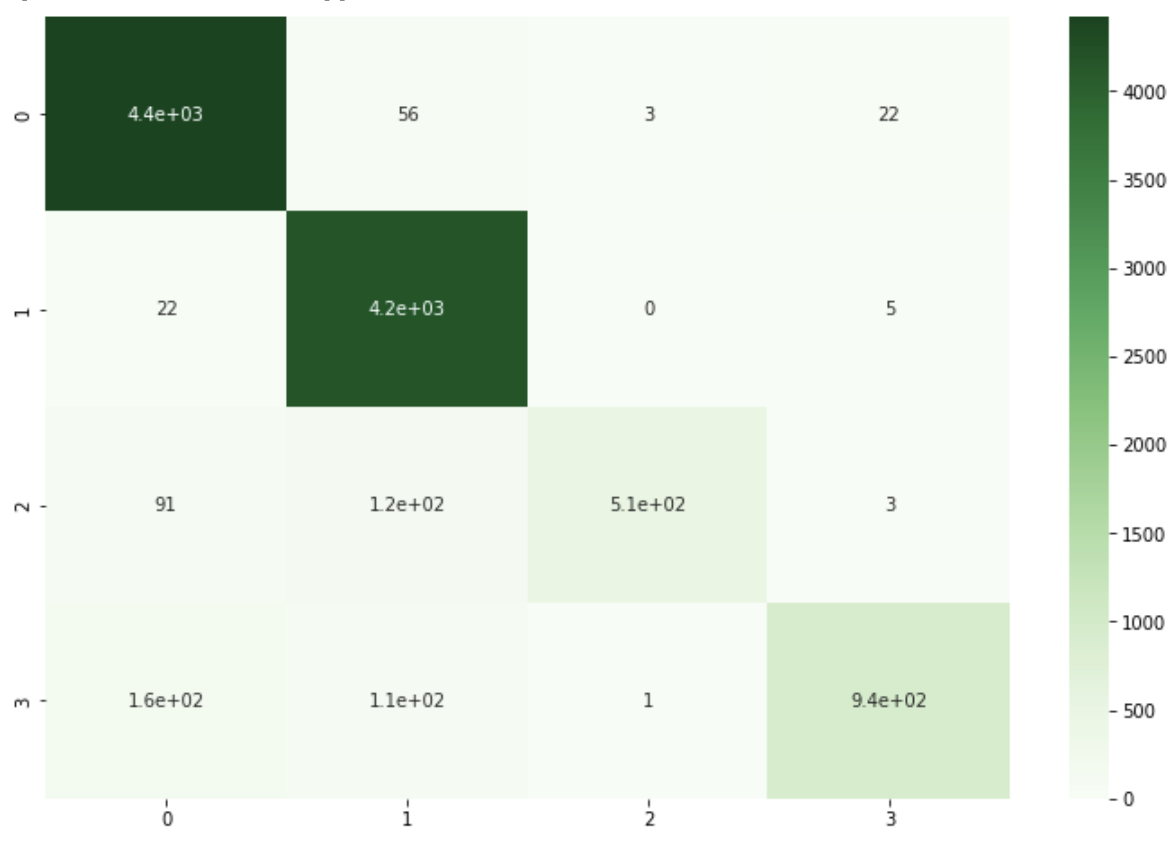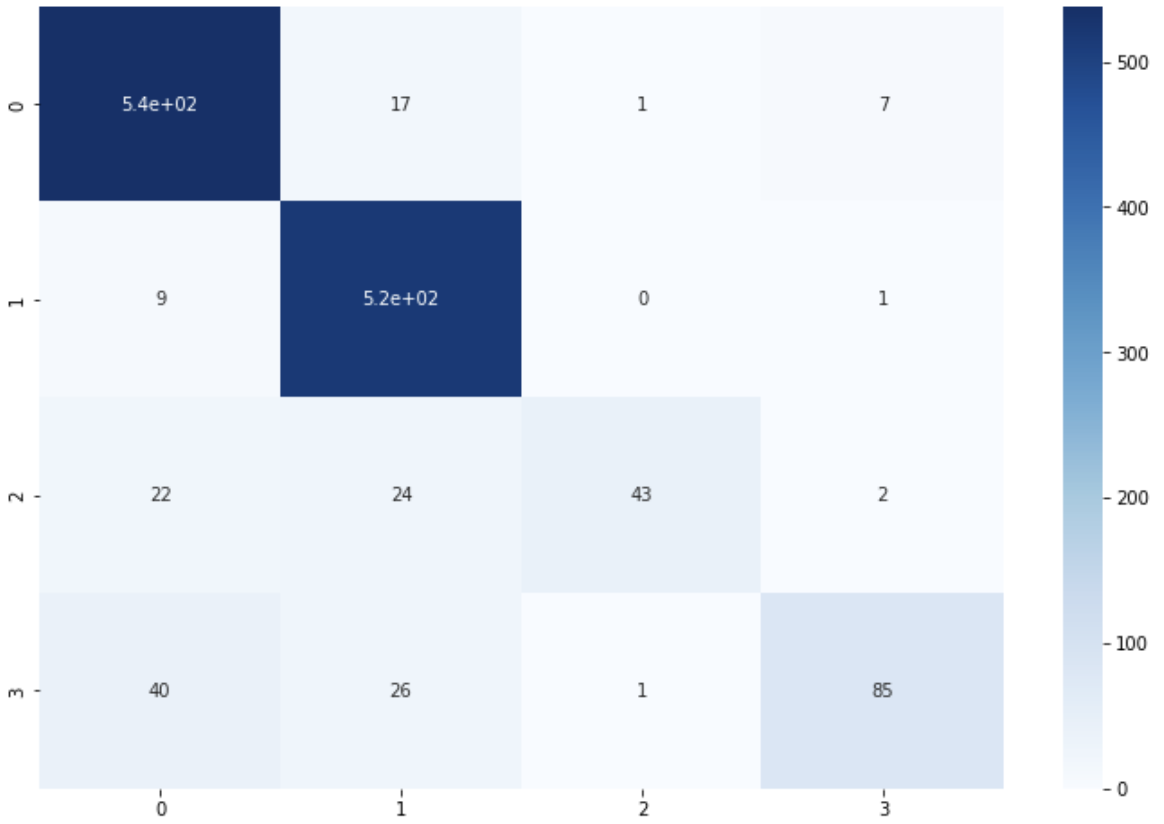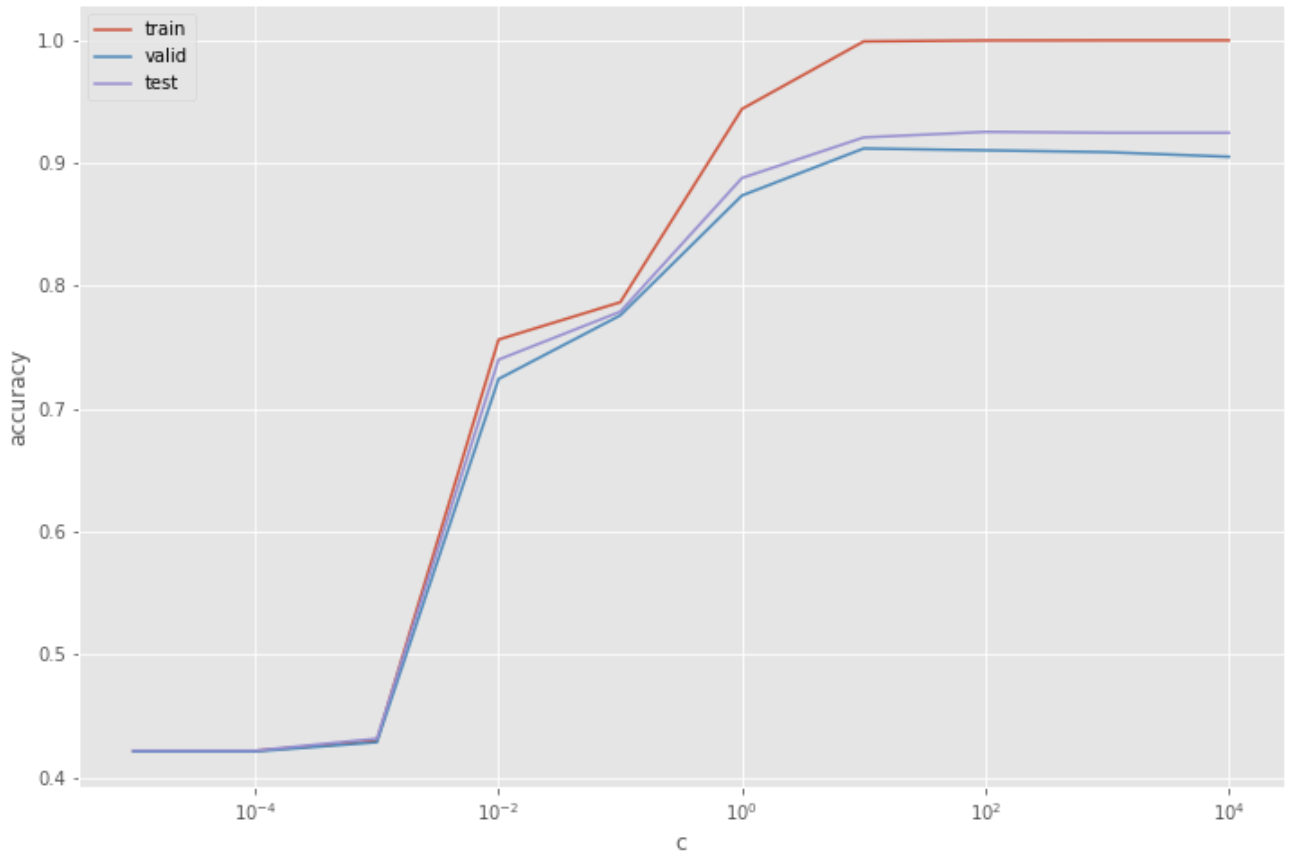はじめに
言語処理100本ノックというNLPに関する問題集が東京工業大学によって作成、管理されています。
この記事では、「第6章: 機械学習」について回答例を紹介します。
50. データの入手・整形
News Aggregator Data Set をダウンロードし、以下の要領で学習データ(
train.txt),検証データ(valid.txt),評価データ(test.txt)を作成せよ.
- ダウンロードした zip ファイルを解凍し,
readme.txtの説明を読む.- 情報源(publisher)が”Reuters”, “Huffington Post”, “Businessweek”, “Contactmusic.com”, “Daily Mail”の事例(記事)のみを抽出する.
- 抽出された事例をランダムに並び替える.
- 抽出された事例の 80%を学習データ,残りの 10%ずつを検証データと評価データに分割し,それぞれ
train.txt,valid.txt,test.txtというファイル名で保存する.ファイルには,1行に1事例を書き出すこととし,カテゴリ名と記事見出しのタブ区切り形式とせよ(このファイルは後に問題 70 で再利用する).学習データと評価データを作成したら,各カテゴリの事例数を確認せよ.
!wget https://archive.ics.uci.edu/ml/machine-learning-databases/00359/NewsAggregatorDataset.zip
!unzip ./NewsAggregatorDataset.zip
!wc -l ./newsCorpora.csv
>> 422937 ./newsCorpora.csv
!head -5 ./newsCorpora.csv
>> 1 Fed official says weak data caused by weather, should not slow taper http://www.latimes.com/business/money/la-fi-mo-federal-reserve-plosser-stimulus-economy-20140310,0,1312750.story\?track=rss Los Angeles Times b ddUyU0VZz0BRneMioxUPQVP6sIxvM www.latimes.com 1394470370698
>> 2 Fed's Charles Plosser sees high bar for change in pace of tapering http://www.livemint.com/Politics/H2EvwJSK2VE6OF7iK1g3PP/Feds-Charles-Plosser-sees-high-bar-for-change-in-pace-of-ta.html Livemint b ddUyU0VZz0BRneMioxUPQVP6sIxvM www.livemint.com 1394470371207
>> 3 US open: Stocks fall after Fed official hints at accelerated tapering http://www.ifamagazine.com/news/us-open-stocks-fall-after-fed-official-hints-at-accelerated-tapering-294436 IFA Magazine b ddUyU0VZz0BRneMioxUPQVP6sIxvM www.ifamagazine.com 1394470371550
>> 4 Fed risks falling 'behind the curve', Charles Plosser says http://www.ifamagazine.com/news/fed-risks-falling-behind-the-curve-charles-plosser-says-294430 IFA Magazine b ddUyU0VZz0BRneMioxUPQVP6sIxvM www.ifamagazine.com 1394470371793
>> 5 Fed's Plosser: Nasty Weather Has Curbed Job Growth http://www.moneynews.com/Economy/federal-reserve-charles-plosser-weather-job-growth/2014/03/10/id/557011 Moneynews b ddUyU0VZz0BRneMioxUPQVP6sIxvM www.moneynews.com 1394470372027
import pandas as pd
df = pd.read_csv(
'./newsCorpora.csv',
header=None,
sep='\t',
names=['ID', 'TITLE', 'URL', 'PUBLISHER', 'CATEGORY', 'STORY', 'HOSTNAME', 'TIMESTAMP']
)
# extract data
df = df.loc[df['PUBLISHER'].isin(['Reuters', 'Huffington Post', 'Businessweek', 'Contactmusic.com', 'Daily Mail']), ['TITLE', 'CATEGORY']]
print(df.sample(5))
>> TITLE CATEGORY
>> 360406 David Arquette gets engaged to Christina McLarty e
>> 110548 Beyonce - Beyonce Makes Surprise Appearance At... e
>> 266665 Airlines struggling to break even will make 'l... b
>> 100350 $84000 For A 12-Week Treatment? Pharma Trade G... m
>> 20232 Study To Test 'Chocolate Pills' For Heart Health m
from sklearn.model_selection import train_test_split
# split data
train, valid_test = train_test_split(
df,
test_size=0.2,
shuffle=True,
random_state=42,
stratify=df['CATEGORY']
)
valid, test = train_test_split(
valid_test,
test_size=0.5,
shuffle=True,
random_state=42,
stratify=valid_test['CATEGORY']
)
# save data
train.to_csv('./train.txt', sep='\t', index=False)
valid.to_csv('./valid.txt', sep='\t', index=False)
test.to_csv('./test.txt', sep='\t', index=False)
# count
print('train', train.shape)
print(train['CATEGORY'].value_counts())
print('\n')
print('valid', valid.shape)
print(valid['CATEGORY'].value_counts())
print('\n')
print('test', test.shape)
print(test['CATEGORY'].value_counts())
train (10672, 2)
b 4502
e 4223
t 1219
m 728
Name: CATEGORY, dtype: int64
valid (1334, 2)
b 562
e 528
t 153
m 91
Name: CATEGORY, dtype: int64
test (1334, 2)
b 563
e 528
t 152
m 91
Name: CATEGORY, dtype: int64
51. 特徴量抽出
学習データ,検証データ,評価データから特徴量を抽出し,それぞれ
train.feature.txt,valid.feature.txt,test.feature.txtというファイル名で保存せよ. なお,カテゴリ分類に有用そうな特徴量は各自で自由に設計せよ.記事の見出しを単語列に変換したものが最低限のベースラインとなるであろう.
import string
import re
from sklearn.feature_extraction.text import TfidfVectorizer
from sklearn.model_selection import train_test_split
def preprocess(text):
text = "".join([i for i in text if i not in string.punctuation])
text = text.lower()
text = re.sub("[0-9]+", "", text)
return text
df = pd.concat([train, valid, test], axis=0)
df.reset_index(drop=True, inplace=True)
df["TITLE"] = df["TITLE"].map(lambda x: preprocess(x))
# split data
train_valid = df[:len(train) + len(valid)]
test = df[len(train) + len(valid):]
# tfidf vectorizer
vec_tfidf = TfidfVectorizer()
# vectorize
x_train_valid = vec_tfidf.fit_transform(train_valid["TITLE"])
x_test = vec_tfidf.transform(test["TITLE"])
# convert vector to df
x_train_valid = pd.DataFrame(x_train_valid.toarray(), columns=vec_tfidf.get_feature_names())
x_test = pd.DataFrame(x_test.toarray(), columns=vec_tfidf.get_feature_names())
# split train and valid
x_train = x_train_valid[:len(train)]
x_valid = x_train_valid[len(train):]
x_train.to_csv('train.feature.txt', sep='\t', index=False)
x_valid.to_csv('valid.feature.txt', sep='\t', index=False)
x_test.to_csv('test.feature.txt', sep='\t', index=False)
print(x_train.sample(5))
aa aaa aaliyah aaliyahs aaron aatha abandon abandoned \
10403 0.0 0.0 0.0 0.0 0.0 0.0 0.0 0.0
5795 0.0 0.0 0.0 0.0 0.0 0.0 0.0 0.0
2506 0.0 0.0 0.0 0.0 0.0 0.0 0.0 0.0
6052 0.0 0.0 0.0 0.0 0.0 0.0 0.0 0.0
2967 0.0 0.0 0.0 0.0 0.0 0.0 0.0 0.0
abandoning abating ... zone zooey zoosk zs zuckerberg zynga \
10403 0.0 0.0 ... 0.0 0.0 0.0 0.0 0.0 0.0
5795 0.0 0.0 ... 0.0 0.0 0.0 0.0 0.0 0.0
2506 0.0 0.0 ... 0.0 0.0 0.0 0.0 0.0 0.0
6052 0.0 0.0 ... 0.0 0.0 0.0 0.0 0.0 0.0
2967 0.0 0.0 ... 0.0 0.0 0.0 0.0 0.0 0.0
œfck œlousyâ œpiece œwaist
10403 0.0 0.0 0.0 0.0
5795 0.0 0.0 0.0 0.0
2506 0.0 0.0 0.0 0.0
6052 0.0 0.0 0.0 0.0
2967 0.0 0.0 0.0 0.0
[5 rows x 14596 columns]
52. 学習
51 で構築した学習データを用いて,ロジスティック回帰モデルを学習せよ.
from sklearn.linear_model import LogisticRegression
import pickle
model = LogisticRegression(random_state=42, max_iter=10000)
model.fit(x_train, train['CATEGORY'])
pickle.dump(model, open('model.pkl', 'wb'))
53. 予測
52 で学習したロジスティック回帰モデルを用い,与えられた記事見出しからカテゴリとその予測確率を計算するプログラムを実装せよ.
print(f"category:{model.classes_}\n")
Y_pred = model.predict(x_valid)
print(f"true (valid):{valid['CATEGORY'].values}")
print(f"pred (valid):{Y_pred}\n")
Y_pred = model.predict_proba(x_valid)
print('predict_proba (valid):\n', Y_pred)
>> category:['b' 'e' 'm' 't']
>>
>> true (valid):['b' 'b' 'b' ... 'e' 'b' 'b']
>> pred (valid):['b' 'b' 'b' ... 'e' 'b' 'b']
>>
>> predict_proba (valid):
>> [[0.62771515 0.24943257 0.05329437 0.06955792]
>> [0.95357611 0.02168835 0.01076999 0.01396555]
>> [0.62374248 0.19986725 0.04322305 0.13316722]
>> ...
>> [0.07126101 0.8699611 0.02801506 0.03076283]
>> [0.97913656 0.01028849 0.00375249 0.00682247]
>> [0.9814316 0.00655014 0.00383028 0.00818798]]
54. 正解率の計測
52 で学習したロジスティック回帰モデルの正解率を,学習データおよび評価データ上で計測せよ.
from sklearn.metrics import accuracy_score
y_pred_train = model.predict(x_train)
y_pred_test = model.predict(x_test)
print(f"train accuracy:{accuracy_score(train['CATEGORY'], y_pred_train): .3f}")
print(f"test accuracy:{accuracy_score(test['CATEGORY'], y_pred_test): .3f}")
train accuracy: 0.944
test accuracy: 0.888
55. 混同行列の作成
52 で学習したロジスティック回帰モデルの混同行列(confusion matrix)を,学習データおよび評価データ上で作成せよ.
from sklearn.metrics import confusion_matrix
import seaborn as sns
import matplotlib.pyplot as plt
# train data
train_cm = confusion_matrix(train['CATEGORY'], y_pred_train)
print(train_cm)
plt.figure(figsize=(12, 8))
sns.heatmap(train_cm, annot=True, cmap='Greens')
plt.show()
[[4421 56 3 22]
[ 22 4196 0 5]
[ 91 125 509 3]
[ 162 111 1 945]]

# test data
test_cm = confusion_matrix(test['CATEGORY'], y_pred_test)
print(test_cm)
plt.figure(figsize=(12, 8))
sns.heatmap(test_cm, annot=True, cmap='Blues')
plt.show()
[[538 17 1 7]
[ 9 518 0 1]
[ 22 24 43 2]
[ 40 26 1 85]]

56. 適合率,再現率,F1 スコアの計測
52 で学習したロジスティック回帰モデルの適合率,再現率,F1 スコアを,評価データ上で計測せよ.カテゴリごとに適合率,再現率,F1 スコアを求め,カテゴリごとの性能をマイクロ平均(micro-average)とマクロ平均(macro-average)で統合せよ.
from sklearn.metrics import precision_score, recall_score, f1_score
import numpy as np
# precision
precision = precision_score(test['CATEGORY'], y_pred_test, average=None, labels=model.classes_)
precision = np.append(precision, precision_score(test['CATEGORY'], y_pred_test, average='micro'))
precision = np.append(precision, precision_score(test['CATEGORY'], y_pred_test, average='macro'))
# recall
recall = recall_score(test['CATEGORY'], y_pred_test, average=None, labels=model.classes_)
recall = np.append(recall, recall_score(test['CATEGORY'], y_pred_test, average='micro'))
recall = np.append(recall, recall_score(test['CATEGORY'], y_pred_test, average='macro'))
# F1
f1 = f1_score(test['CATEGORY'], y_pred_test, average=None, labels=['b', 'e', 't', 'm'])
f1 = np.append(f1, f1_score(test['CATEGORY'], y_pred_test, average='micro'))
f1 = np.append(f1, f1_score(test['CATEGORY'], y_pred_test, average='macro'))
scores = pd.DataFrame({'precision': precision, 'recall': recall, 'F1': f1},
index=['b', 'e', 't', 'm', 'micro avg', 'macro avg'])
print(scores)
precision recall f1
b 0.883415 0.955595 0.918089
e 0.885470 0.981061 0.930818
t 0.955556 0.472527 0.688259
m 0.894737 0.559211 0.632353
micro avg 0.887556 0.887556 0.887556
macro avg 0.904794 0.742098 0.792380
57. 特徴量の重みの確認
52 で学習したロジスティック回帰モデルの中で,重みの高い特徴量トップ 10 と,重みの低い特徴量トップ 10 を確認せよ.
features = x_train.columns.values
index = [i for i in range(1, 11)]
for c, coef in zip(model.classes_, model.coef_):
print(f'category: {c}', '*' * 100)
best_10 = pd.DataFrame(features[np.argsort(coef)[::-1][:10]], columns=['best 10'], index=index).T
worst_10 = pd.DataFrame(features[np.argsort(coef)[:10]], columns=['worst 10'], index=index).T
print(pd.concat([best_10, worst_10], axis=0))
print('\n')
category: b ****************************************************************************************************
1 2 3 4 5 6 7 8 9 \
best 10 fed bank ecb china oil ukraine euro update stocks
worst 10 and the her ebola facebook she video study kardashian
10
best 10 buy
worst 10 google
category: e ****************************************************************************************************
1 2 3 4 5 6 7 8 9 \
best 10 kardashian chris kim she her cyrus miley star paul
worst 10 update us google says ceo study billion china could
10
best 10 movie
worst 10 facebook
category: m ****************************************************************************************************
1 2 3 4 5 6 7 8 \
best 10 ebola cancer study drug fda mers health virus
worst 10 gm facebook climate ceo apple twitter deal google
9 10
best 10 could heart
worst 10 sales buy
category: t ****************************************************************************************************
1 2 3 4 5 6 7 \
best 10 google facebook apple climate microsoft gm tmobile
worst 10 her at drug fed but american shares
8 9 10
best 10 samsung heartbleed tesla
worst 10 cancer bank stocks
58. 正則化パラメータの変更
ロジスティック回帰モデルを学習するとき,正則化パラメータを調整することで,学習時の過学習(overfitting)の度合いを制御できる.異なる正則化パラメータでロジスティック回帰モデルを学習し,学習データ,検証データ,および評価データ上の正解率を求めよ.実験の結果は,正則化パラメータを横軸,正解率を縦軸としたグラフにまとめよ.
from tqdm import tqdm
import matplotlib.pyplot as plt
plt.style.use('ggplot')
c_list = np.logspace(-5, 4, 10, base=10)
# models = [LogisticRegression(C=C, random_state=42, max_iter=1000).fit(x_train, train['CATEGORY']) for C in tqdm(c_list)]
train_accs = [accuracy_score(model.predict(x_train), train['CATEGORY']) for model in models]
valid_accs = [accuracy_score(model.predict(x_valid), valid['CATEGORY']) for model in models]
test_accs = [accuracy_score(model.predict(x_test), test['CATEGORY']) for model in models]
plt.plot(c_list, train_accs, label = 'train')
plt.plot(c_list, valid_accs, label = 'valid')
plt.plot(c_list, test_accs, label = 'test')
plt.xscale('log')
plt.xlabel('c')
plt.ylabel('accuracy')
plt.legend()
plt.show()

59. ハイパーパラメータの探索
学習アルゴリズムや学習パラメータを変えながら,カテゴリ分類モデルを学習せよ.検証データ上の正解率がもっとも高くなる学習アルゴリズム・パラメータを求めよ.また,その学習アルゴリズム・パラメータを用いたときの評価データ上の正解率を求めよ.
!pip install optuna
import optuna
def objective(trial):
model = LogisticRegression(random_state=42,
max_iter=10000,
penalty='elasticnet',
solver='saga',
l1_ratio=trial.suggest_uniform('l1_ratio', 0, 1),
C=trial.suggest_loguniform('C', 1e-4, 1e2))
model.fit(x_train, train['CATEGORY'])
valid_accuracy = accuracy_score(model.predict(x_valid), valid['CATEGORY'])
return valid_accuracy
study = optuna.create_study(direction='maximize')
study.optimize(objective, n_trials=2, timeout=3600)
print('Best trial:')
trial = study.best_trial
print(' Value: {:.3f}'.format(trial.value))
print(' Params: ')
for key, value in trial.params.items():
print(' {}: {}'.format(key, value))
>> Best trial:
>> Value: 0.657
>> Params:
>> l1_ratio: 0.8173726339927334
>> C: 0.08584685734174859
model = LogisticRegression(random_state=42,
max_iter=10000,
penalty='elasticnet',
solver='saga',
l1_ratio=trial.params['l1_ratio'],
C=trial.params['C'])
model.fit(x_train, train['CATEGORY'])
y_pred_train = model.predict(x_train)
y_pred_valid = model.predict(x_valid)
y_pred_test = model.predict(x_test)
train_accuracy = accuracy_score(train['CATEGORY'], y_pred_train)
valid_accuracy = accuracy_score(valid['CATEGORY'], y_pred_valid)
test_accuracy = accuracy_score(test['CATEGORY'], y_pred_test)
print(f'accuracy (train):{train_accuracy:.3f}')
print(f'accuracy (valid):{valid_accuracy:.3f}')
print(f'accuracy (test):{test_accuracy:.3f}')
>> accuracy (train):0.668
>> accuracy (valid):0.657
>> accuracy (test):0.653
参考